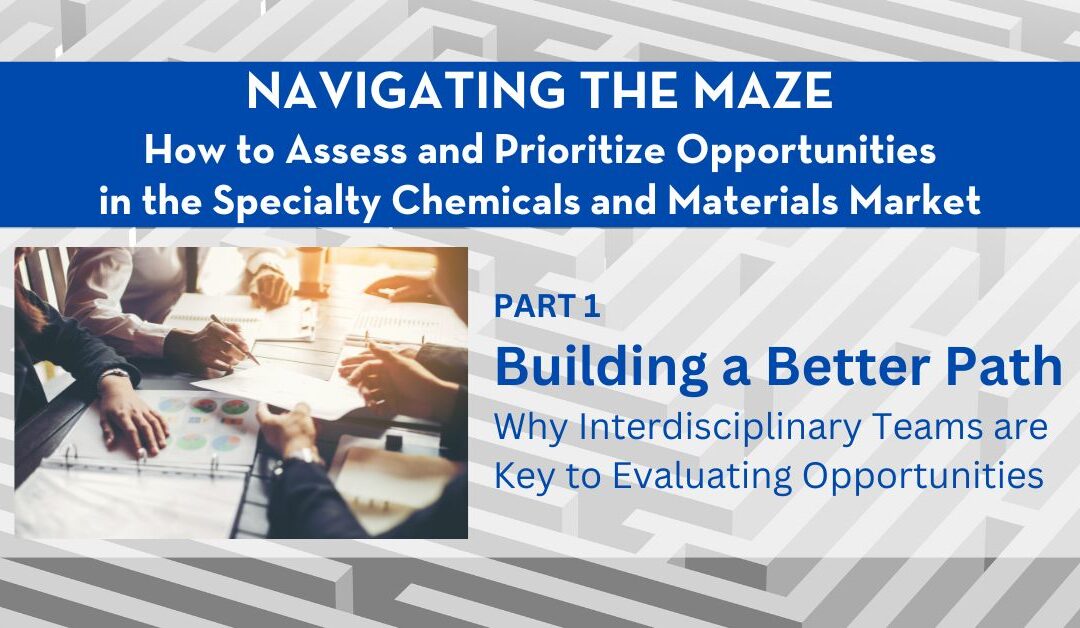Table of Contents
In the specialty chemicals and materials industry, the pace of innovation, shifting customer needs, and growing regulatory complexity make it challenging to determine where to invest time, talent, and resources. Whether you’re evaluating new R&D initiatives, exploring emerging markets, or launching new product lines, the path forward can often feel uncertain. That’s where a structured, interdisciplinary approach can help.
In this four-part series, we’ll explore how to effectively assess and prioritize opportunities. We’ll outline a repeatable process grounded in cross-functional collaboration and practical decision-making frameworks. Our goal is to help you make smarter, faster decisions that align with both your organization’s capabilities and the market’s potential.
The Case for Interdisciplinary Collaboration
At the heart of a successful opportunity assessment is a diverse team. Too often, decisions are made in silos—by R&D without input from commercial teams, or by marketing without an understanding of technical feasibility. An interdisciplinary team prevents tunnel vision by bringing together different perspectives and expertise early in the process.
In the specialty chemicals and materials industry, this collaboration is especially critical due to the highly technical nature of products and the complexity of scale-up, production, and commercialization. Building a cross-functional team ensures you assess not only whether the opportunity exists, but whether it’s truly viable from every angle.
Who Should Be at the Table?
An effective assessment team includes individuals with expertise in:
- Technical/R&D: Evaluate performance targets, feasibility, formulation strategies, and technical options
- Manufacturing/operations: Analyze scale-up potential, process complexity, capital requirements, and compliance issues
- Sales and marketing: Bring voice-of-the-customer insights, assess competitive positioning, and evaluate the potential for differentiation
- Regulatory/ESG: Ensure early-stage awareness of environmental and compliance risks
- Finance/strategy: Assess ROI, potential investment requirements, and long-term alignment with business goals
Depending on the project scope, involving third-party experts can also be valuable. External advisors provide an unbiased view, benchmark performance against industry best practices, and offer strategic input based on broader market experience.

Aligning Early Around a Common Framework
Once your team is assembled, the next step is agreeing on the decision-making framework. This includes:
- A clear definition of success (e.g., revenue potential, IP creation, strategic positioning)
- Evaluation criteria (more on this in upcoming posts)
- Scoring methodology and weighting
- Timeline for assessment
- Roles and responsibilities
This shared framework allows your team to operate efficiently, avoid redundant work, and ensure accountability.
Collaboration in Action: A Hypothetical Example
Imagine a company evaluating an opportunity to develop a bio-based raw material for the coatings industry. Without interdisciplinary input, the technical team might green-light the project based on lab feasibility alone. But a manufacturing representative might point out that the required feedstock can’t be sourced locally. Meanwhile, marketing might reveal that while sustainability is valued, price sensitivity in the target coating market is high — thus limiting premium positioning.
When teams work in isolation, critical constraints are often discovered too late. An interdisciplinary team ensures those constraints are surfaced and addressed up front, saving time and reducing risk.
Download the full
navigating the maze white paper
What Happens When You Skip this Step?
Without interdisciplinary alignment, companies risk:
- Developing technically impressive products that no one wants to buy
- Underestimating scale-up costs or regulatory timelines
- Misjudging market readiness
- Missing red flags until significant resources have been invested
In today’s volatile and resource-constrained environment, those missteps can be costly.
Looking Ahead
In the next blog post, we’ll dive into market assessment and commercial considerations, two pillars of opportunity evaluation that reveal whether the market is large enough, growing fast enough, and accessible enough to justify investment.
If you’re in the specialty chemicals and materials industry and want to drive more confident decision making, start by building your team. Cross-functional collaboration isn’t just good practice — it’s your first step toward a smarter strategy.
To learn more, reach out to the author at cmorrison@chemquest.com.
How can we help you? Let’s start talking: https://chemquest.com/lets-start-talking/


